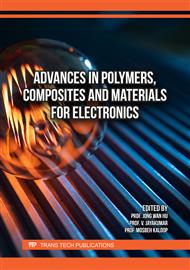[1]
Z. Hashin, Analysis of Composite Materials- A Survey, Trans. ASME J. of Applied Mechanics. 50 (1983) 481-505.
Google Scholar
[2]
T. Iwakuma, S. Nemat-Nasser, Composites with periodic structure, Computers and Structures. 16 (1983) 13-19.
DOI: 10.1016/0045-7949(83)90142-6
Google Scholar
[3]
P.R. Smith, F.H. Froes, Developments in Titanium metal matrix composites, J. Materials. 36 (1984) 19-26.
Google Scholar
[4]
K. Takahashi, T-W. Chou, Transverse elastic moduli of unidirectional fiber composites with interfacial debonding, Metall. Trans. A. 19A (1988) 129-135.
DOI: 10.1007/bf02669821
Google Scholar
[5]
J. Aboudi, Micromechanical analysis of composites by the method of cells, App. Mech. Rev. 42 ( 1989)193-221.
Google Scholar
[6]
J.R. Brockenbrough, S. Suresh, H.A. Wienecke, Deformation of metal-matrix composites with continuous fibers: Geometrical effects of fiber distribution and shape, Acta Metall Mater. 39 (1991) 735-752.
DOI: 10.1016/0956-7151(91)90274-5
Google Scholar
[7]
A. Ramakrishna, Finite Element Analysis of Heat Conduction and Thermal Stresses in Laminated Composite Plates, Ph.D. Thesis, Mechanical Engineering Department, IIT, Kharagpur, 1991.
Google Scholar
[8]
M.G. Phillips, Simple geometrical models for Young's modulus of fibrous and particulate composites, Compos Sci Technol. 43 (1992) 95-100.
DOI: 10.1016/0266-3538(92)90136-q
Google Scholar
[9]
J.R. Yeh, Effect of interface on the transverse properties of composites, Int J Solids Struct. 29 (1992) 2493-2502.
Google Scholar
[10]
S.L. Dong, R.W. Michael, Finite element micromechanical modeling of unidirectional fiber-reinforced metal- matrix composites, Compos Sci Technol. (1994) 545-563.
Google Scholar
[11]
S. Hui –Z, C. Tsu-W, Transverse elastic moduli of unidirectional fiber composites with fiber/matrix interfacial debonding, Compos Sci Technol. 53 (1995) 383-391.
DOI: 10.1016/0266-3538(95)00026-7
Google Scholar
[12]
L.E. Asp, L. A. Berglund, R. Talreja, Effects of fiber and interphase on matrix-initiated transverse failure in polymer composites, Compos Sci Technol. 56 (1996) 657-665.
DOI: 10.1016/0266-3538(96)00047-4
Google Scholar
[13]
S.T. Pericles, G.E. Stavronlakis, P.D. Panagiotopoulos, Calculation of Effective Transverse Elastic Moduli of Fiber-Reinforced Composites by Numerical Homogenization, Compos Sci Technol. 57 (1997) 573-586.
DOI: 10.1016/s0266-3538(97)00018-3
Google Scholar
[14]
S. Li, On the unit cell for micromechanical analysis of fiber reinforced composites, Proc. R Soc. London A, 1999, pp.815-838.
Google Scholar
[15]
A. B. Morais, Transverse moduli of continuous-fiber-reinforced polymers, Compos Sci Technol. 60 (2000) 997-1002.
Google Scholar
[16]
P. Prashanthi, V. Balakrishna Murthy, U. Koteswara Rao, Effect of Mismatch in Young's Modulus on Micromechanical Behaviour of FRP Composites under Transverse Loading, International Conference On Total Engineering, Analysis & Manufacturing Technologies, Bangalore, 2009, p.29.
Google Scholar
[17]
P. Prashanthi, V. Balakrishna Murthy, U. Koteswara Rao, K. Mohana Rao, Effect of Mismatch in Poisson's Ratio on Micromechanical Behaviour of FRP Composites under Longitudinal Loading, Int J Appl Eng Res. 5 (2010) 1255-1260.
Google Scholar
[18]
P. Prashanthi, V. Balakrishna Murthy, U. Koteswara Rao, K. Mohana Rao, Effect of Mismatch in Young's Modulus on Micromechanical Behaviour of FRP Composites under Longitudinal Loading, International Journal of Material Science. 5 (2010) 503–509.
Google Scholar
[19]
A. Srihari Prasad, K. V. Ramana, V. Balakrishna Murthy, G. S. Rao, Role of finite element method (FEM) in predicting transverse modulus of fiber-reinforced polymer (FRP) composites: A revelation, International Journal of Physical Sciences. 8 (2013) 1341-1349.
Google Scholar
[20]
V. S. Sai, M. R. S. Satyanarayana, V. B. K. Murthy, G. S. Rao, A. S. Prasad, An Experimental Simulation to Validate FEM to Predict Transverse Young's Modulus of FRP Composites, Advances in Materials Science and Engineering, Hindawi Publication Corporation. 2013 (2013), 1-6.
DOI: 10.1155/2013/648527
Google Scholar
[21]
K.B. Shingare, S. Naskar, Probing the prediction of effective properties for composite materials, Eur J Mech A Solids. 87 (2021) 1-18.
Google Scholar
[22]
Lei Wan, Yaser Ismail, Yong Sheng, Jianqiao Ye, Dongmin Yang, A review on micromechanical modelling of progressive failure in unidirectional fibre-reinforced composites, Composites Part C. 10 (2023) 1-19.
DOI: 10.1016/j.jcomc.2023.100348
Google Scholar
[23]
ANSYS reference manuals, 2023.
Google Scholar



